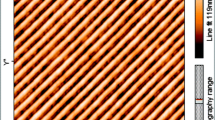Abstract
Substantial increases in fluorescence emission from fluorophore-protein–coated fractal-like silver structures have been observed. We review two methods for silver fractal structure preparation, which have been employed and studied. The first, a roughened silver electrode, typically yielded a 100-fold increase in fluorophore emission, and the second, silver fractal-like structures grown on glass between two silver electrodes, produced a ≈500-fold increase. In addition, significant increases in probe photostability were observed for probes coated on the silver fractal like structures. These results further serve to compliment our recent work on the effects of nobel metal particles with fluorophores, a relatively new phenomenon in fluorescence we have termed both “metal-enhanced fluorescence” [1] and “radiative decay engineering” [2,3]. These results are explained by the metallic surfaces modifying the radiative decay rate (Γ) of the fluorescent labels. We believe that this new silver-surface preparation, which results in ultrabright and photostable fluorophores, offers a new generic technology platform for increased fluorescence signal levels, with widespread potential applications to the analytical sciences, imaging, and medical diagnostics.
Similar content being viewed by others
REFERENCES
C. D. Geddes and J. R. Lakowicz (2002) Metal-enhanced fluorescence. J. Fluoresc. 12(2), 121–129.
J. R. Lakowicz (2001) Radiative decay engineering: Biophysical and biomedical applications. Anal. Biochem. 298, 1–24.
J. R. Lakowicz, Y. Shen, S. D'Auria, J. Malicka, J. Fang, Z. Gryczynski, and I. Gryczynski (2002) Radiative decay engineering 2: Effects of silver island films on fluorescence intensity lifetimes and resonance energy transfer. Anal. Biochem. 301, 261–277.
J. Malicka, I. Gryczynski, J. Kusba, Y. Shen, and J. R. Lakowicz (2002) Effects of metallic silver particles on resonance energy transfer in labeled bovine serum albumin. Biochem. Biophys. Res. Commun. 294, 886–892.
C. D. Geddes, H. Cao, I. Gryczynski, Z. Gryczynski, J. Fang, and J. R. Lakowicz (2003) Metal-enhanced fluorescence (MEF) due to silver colloids on a planar surface: Potential applications of indocyanine green to in vivo imaging. J. Phys. Chem. A 107, 3443–3449.
J. R. Lakowicz, J. Malicka, I. Gryczynski, Z. Gryczynski, and C. D. Geddes (2003) Radiative decay engineering: The role of photonic mode density in biotechnology. J. Phys. D In Press.
J. R. Lakowicz, I. Gryczynski, Y. B. Shen, J. Malicka, and Z. Gryczynski, (2001) Intensified fluorescence. Photonics Spectra 35(10), 96–104.
C. D. Geddes, A. Parfenov, and J. R. Lakowicz (2003) Photodeposition of silver can result in metal-enhanced fluorescence. Appl. Spectrosc. 57, 526–531.
C. D. Geddes, A. Parfenov, D. Roll, J. Fang, and J. R. Lakowicz (2003) Electrochemical and laser deposition of silver for use in metal-enhanced fluorescence. Langmuir In Press.
N. Christodoulides, M. Tran, P. N. Floriano, M. Rodriguez, A. Goodey, M. Ali, D. Neikirk, and J. T. McDevitt (2002) A microchip-based multianalyte assay system for the assessment of cardiac risk. Anal. Chem. 74, 3030–3036.
E. Verpoorte (2002) Microfluidic chips for clinical and forensic analysis. Electrophoresis 23, 677–712.
R. Keir, E. Igata, M. Arundell, W. E. Smith, D. Graham, C. McHugh, and J. M Cooper (2002) SERRS: In situ substrate formation and improved detection using microfluidics. Anal. Chem. 74(7), 1503–1508.
C. L. Haynes, A. D. McFarland, M. T. Smith, J. C. Hulteen, and R. P. Van Duyne (2002) Angle-resolved nanosphere lithography: Manipulation of nanoparticle size, shape, and interparticle spacing. J. Phys. Chem. B 106, 1898–1902.
F. Hua, T. Cui, and Y. Lvov (2002) Lithographic approach to apttern self-assembled nanoparticle multilayers. Langmuir 18, 6712–6715.
V. Fleury, W. A. Watters, L. Allam, and T. Devers (2002) Rapid electroplating of insulators. Nature 416, 716–719.
M. Fleischmann, P. J. Hendra, and A. J. McQuillan, (1974) Raman spectra of pyridine adsorbed at a silver electrode. Chem. Phys. Letts. 26(2), 163–166.
E. Roth, G. A. Hope, D. P. Schweinsberg, W. Kiefer, and P. M. Fredericks, (1993) Simple technique for measuring surface-enhanced fourier transform Raman spectra of organic compounds. Appl. Spec. 47(11), 1794–1800.
C. D. Geddes, A. Parfenov, D. Roll, I. Gryczynski, J. Malicka, and J. R. Lakowicz, (2003) Roughened silver electrodes for use in metal-enhanced fluorescence. Photochem. Photobiol. Submitted.
A. Parfenov, I. Gryczynski, J. Malicka, C. D. Geddes, and J. R. Lakowicz, (2003) Enhanced fluorescence from fluorophores on fractal silver surfaces. Jn. Phys. Chem. B In Press.
A. M. Michaels, J. Jiang, and L. Brus, (2000) Ag nanocrystal junctions as the site for surface-enhanced Raman scattering of single rhodamine 6G molecules. J. Phys. Chem. B. 104, 11965–11971.
A. M. Michaels, M. Nirmal, and L. E. Brus (1999) Surface enhanced Raman spectroscopy of individual rhodamine 6G molecules on large Ag nanocrystals. J. Am. Chem. Soc. 121, 9932–9939.
J. R. Lakowicz, J. Malika, S. D'Auria, and I. Gryczynski (2002) Release of self-quenching of fluorescence near metallic surfaces. Anal. Biochem. In Press.
K. Sokolov, G. Chumanov, and T. M. Cotton (1998) Enhancement of molecular fluorescence near the surface of colloidal metal films. Anal. Chem. 70, 3898–3905.
J. P. Abid, A. W. Wark, P. F. Brevet, and H. H. Girault (2002) Preparation of silver nanoparticles in solution from a silver salt by laser irradiation. Chem. Commun. 7, 792–793.
E. J. Bjerneld, K. V. G. K. Mutry, J. Prikulis, and M. Kall (2002) Laser-induced growth of Ag nanoparticles from aqueous solutions. Chem. Phys. Chem. 116–119.
I. Pastoriza-Santos, C. Serra-Rodriguez, and L. M. Liz-Marzan (2000) Self-assembly of silver particle monolayers on glass from Ag+ solutions in DMF. J. Colloid Interface Sci. 221, 236–241.
L. A. Porter, H. C. Choi, A. E. Ribbe, and J. M. Buriak (2002) Controlled electroless deposition of noble metal nanoparticles films on germanium surfaces. Nano. Lett. 2(10), 1067–1071.
Author information
Authors and Affiliations
Corresponding author
Rights and permissions
About this article
Cite this article
Geddes, C.D., Parfenov, A., Roll, D. et al. Silver Fractal-Like Structures for Metal-Enhanced Fluorescence: Enhanced Fluorescence Intensities and Increased Probe Photostabilities. Journal of Fluorescence 13, 267–276 (2003). https://doi.org/10.1023/A:1025046101335
Issue Date:
DOI: https://doi.org/10.1023/A:1025046101335




